China’s Sanctions Enforcement and Fuel Prices in North Korea: What the Data Tells Us
China is by far North Korea’s largest trading partner, accounting for up to 90 percent of its trade flows. Therefore, how much the Trump administration’s “maximum pressure” campaign affects North Korea’s most crucial export and imports is primarily a function of China’s enforcement of sanctions. This essay argues that, while Chinese sanctions enforcement has been relatively stringent in the era of “maximum pressure,” the PRC has sought to ensure stability and help North Korea avoid strenuous hardship by adjusting its fuel supplies according to geopolitical circumstances, among other factors.[1] The fluctuation in Chinese fuel supplies over the past 18 months suggests that Beijing has been opening and closing its tap largely according to its national security priorities, rather than a robust and abiding commitment to comply with the letter and spirit of the international sanctions regime.
Download the full report in PDF | China’s Sanctions Enforcement and Fuel Prices in North Korea: What the Data Tells Us
Methodology and Approach
There are several reasons why fuel prices are an important part of the narrative for sanctions pressure on North Korea. First, China is North Korea’s most important fuel supplier. In an average year, the state-owned China National Petroleum Corporation (CNPC) supplies North Korea with around 520,000 tons of crude oil.[2] It is unclear precisely what proportions of the crude oil shipments North Korea pays for and how it makes payments, but a significant share is likely shipped on concessionary terms by the pipeline running through China’s Liaoning province to the Ponghwa Chemical Factory refinery near Sinuiju in North Korea. In addition, North Korea likely procures oil and fuel products in smaller quantities from a number of other countries, primarily Russia, through dealers based abroad. Whatever the proportions may be, however, the overwhelming share of North Korea’s fuel supply—judging by currently available data—originates from China.
Several United Nations Security Council (UNSC) resolutions adopted in 2017 severely limit the quantities of oil and fuel products that member states are allowed to export or “transfer” to North Korea. Resolution 2397, adopted in December 2017, stated that member states are not allowed to ship more than 4 million barrels or 525,000 tons per year of such products to North Korea.[3] Consequently, fuel prices are a telling proxy for Chinese economic pressure on North Korea. These prices depend on a wide range of variables other than Chinese supply. But any major shifts in prices, especially those that morph into a longer-run trend rather than temporary spikes, likely depend either on changes in direct Chinese supply, or Chinese stringency in enforcing sanctions by preventing trade via smuggling and regular sales.
Chinese maximum pressure is not merely about ordering major state suppliers to draw down on their fuel sales to North Korea. Border controls and anti-smuggling enforcement are just as crucial. According to official Chinese data, exports of fuel to North Korea have generally remained low over the past 18 months. This data, however, may not include oil transfers on concessionary terms. It certainly does not include illegal ship-to-ship-transfers and other fuel smuggling operations, many of which have likely been, and still are, conducted by ships and traders of Chinese origins.[4] It may not be fair to directly fault the Chinese government with smuggling operations providing fuel to North Korea. However, it is reasonable to assume, given China’s naval military strength, that it could halt such operations should it decide to do so.[5]
China’s Recent Pattern of Trade with North Korea and Sanctions Adherence
For years, even when the UNSC imposed stiff sanctions on North Korea, China continued to trade with the country. UNSC Resolution 2270, adopted in March 2016, decided that “…the DPRK shall not supply, sell or transfer, directly or indirectly…coal, iron, and iron ore, and that all States shall prohibit the procurement of such material from the DPRK by their nationals…”[6] The resolution, however, contained a provision that excluded “[t]ransactions that are determined to be exclusively for livelihood purposes and unrelated to generating revenue for the DPRK’s nuclear or ballistic missile programs…”. Although coal imports dwindled in the month that sanctions were supposed to take effect, they soared in August of the same year to their highest levels on record to date. In other words, trade first dropped when the spotlight was on North Korea and China’s sanctions implementation, but resumed shortly thereafter, when international attention shifted elsewhere.
The spirit of the sanctions was clear, but by choosing instead a literal interpretation, China could continue with business as usual, while claiming—with some credibility, given how little is publicly known about North Korea’s enterprise structures—that the proceeds of sanctioned goods it imported did go towards “humanitarian proceeds.”
In 2017–2018, however, things changed. Most likely spurred by Chinese concerns over the escalating tensions between the US and North Korea rather than primarily a genuine concern for UN sanctions implementation, the Chinese government took real action to strike at North Korea economically. For example, between May and June of 2017, CNPC drastically drew down on the quantities of fuel it sold to North Korea, and in late June, even suspended sales completely, allegedly out of concerns that North Korea wouldn’t be able to pay.[7] Though the action was ostensibly taken on commercial grounds, the timing strongly suggests that geopolitical tensions were a major factor.
As several rounds of sanctions were added in response to North Korea’s intercontinental ballistic missile (ICBM) and nuclear testing in 2017, China’s trade with North Korea dropped precipitously. Beginning in September 2017, the month after the UNSC passed a resolution banning imports of North Korean minerals (including coal) and fisheries products, Chinese imports of North Korean goods fell steeply for several months and in December—a period of high tensions between the US and DPRK—they dropped by a whopping 83 percent compared with the same month in 2016. In April 2018, North Korean exports had dropped by 89 percent as compared to the same month in 2017.[8] Between January and September of 2018, however, China imported only a negligible amount of goods from North Korea: out of a total trade volume of 11.11 billion yuan, 10.11 billion consisted of exports.[9] This represented a drop of 59.2 percent from the previous year, and imports were down by a massive 90.1 percent from the past year.
China has a clear political and strategic interest in claiming that it is fully abiding by UNSC resolutions, but the question remains how North Korea is financing this massive trade deficit. Either China has been shipping large quantities of goods to North Korea basically for free, or has done so on promises of future payments. Moreover, China has likely been shipping substantial quantities of oil and fuel products to North Korea through various channels not covered by official trading statistics, perhaps by concessionary shipments through the pipeline to North Korea’s Sinuiju. One source told South Korea’s Chosun Ilbo in July 2018 that Beijing’s oil shipments “doubled” after Kim Jong Un’s third visit to China in June of 2018, and shipments of fertilizer also increased greatly.[10]
Though it did not provide a figure, China may already have, or could be on the way, to transferring far more oil to North Korea than the 560,000 tons allowed per year under current sanctions. One estimate holds that 30–40,000 tons per month in the summer and 80,000 tons during the winter must be transmitted through the pipeline to ensure that it does not clog up.[11] Should it send even 40,000 on average per month, that would amount to 480,000 tons per year. Since quantities are presumably bigger especially in colder months, the amounts would quickly add up to above 560,000 tons.
Analysis: North Korean Fuel Prices Through “Maximum Pressure”
To understand the dynamics of Chinese pressure and fuel prices in North Korea, consider the following graph showing prices for diesel and gasoline. It shows that both prices tend to move in the same direction, though gasoline price movements are more pronounced and wider. The price data comes from the Daily NK price index for North Korean markets.[12]
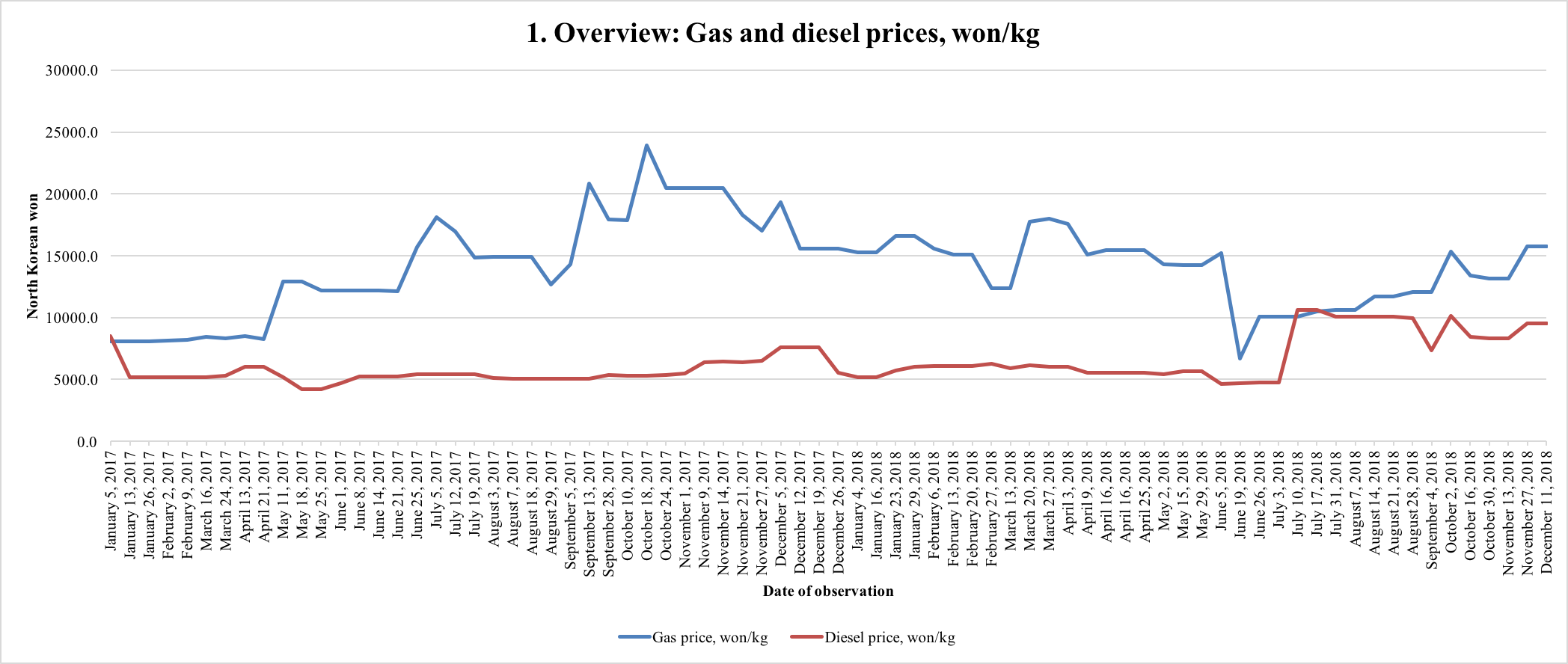
Gas prices first climbed between March and April 2017. This is around the time that CNPC declared it drew down and eventually ceased shipments to North Korea, and coincides with North Korea’s main public holiday, Kim Il Sung’s birthday when the government needs fuel to run the celebratory military parade. Though CNPC said it would only cease shipments from June, it makes sense that the price increase should come earlier given that the news was put out in public. CNPC reportedly first drew down on shipments incrementally over several months, and the price hike shown for late April 2017 may have been the first concrete piece of evidence for the decrease in supply.
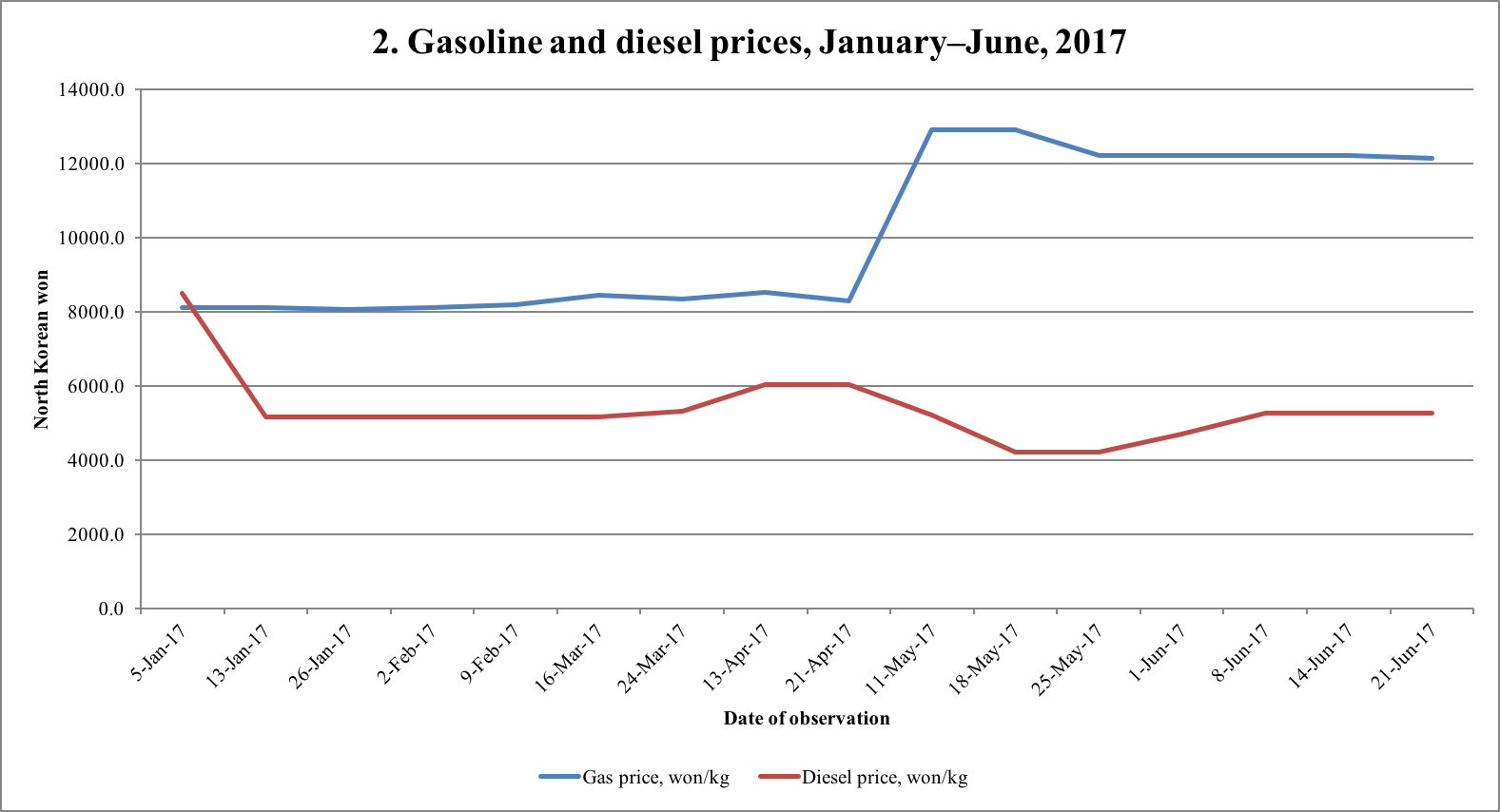
Prices subsequently moved roughly in accordance with the ups and downs of geopolitical tensions, with the direct cause likely being hoarding by private citizens, the KPA, and other state organs and businesses, and most importantly, a decrease in Chinese supply. With periodic exceptions, prices continued to climb throughout much of the spring, summer and fall of 2017, peaking in mid-October. During this period, North Korea tested several missiles, including one ICBM in early July. The price increase shown in graph 3, however, was first observed in the data in late June, suggesting that the KPA began soaking up gasoline from the markets in anticipation of tighter supply following the ICBM test.
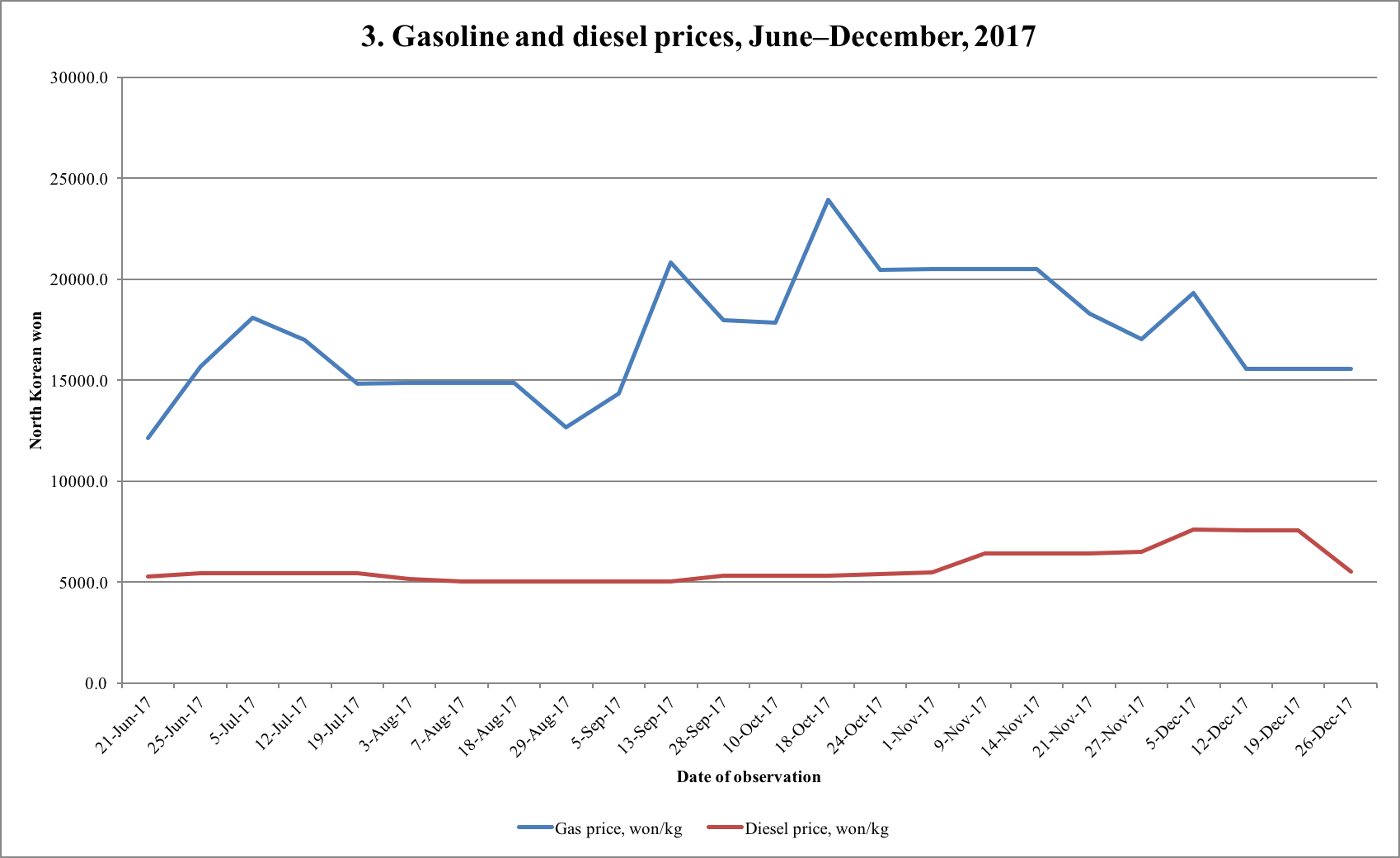
In September, the country claimed a successful nuclear test. Several rounds of sanctions followed, culminating with the limit on oil and fuel transfers adopted on December 22. Most likely, in this period, prices were pushed up by hoarding, lower Chinese supply and more strict sanctions monitoring, as US pressure on China remained exceptionally strong.
Prices began to decline throughout the early part of 2018, though they remained higher than normal. During this period, US pressure on the international community, and China in particular, to monitor and adhere to sanctions remained strong. At the same time, the high but stable price level strongly suggests that China continued to provide enough fuel products to North Korea to meet its most basic needs.
During this period, North Korea did not conduct any tests of missiles or nuclear weapons. Thus, implicit pressure on China to aid in the campaign of maximum pressure declined, even with the US continuously demanding that the sanctions regime be vigilantly enforced. Prices did not drop significantly as US-North Korea ties warmed with the announcement of the Trump-Kim summit in early March. At the time, however, US pressure remained high for the international community to keep the sanctions regime together, and the Chinese government likely wanted to project an image of supporting the diplomatic efforts, while cautiously and relatively slowly normalizing supply.
The general price level also moved in tandem with China-North Korea relations. It first dropped slightly in late March of 2018, around the time of Kim Jong Un’s first visit to China. Right at the same time as Kim’s third visit to China, on June 19, gas prices dropped by over 50 percent. Prices remained at this level throughout the summer. Graph 4 below illustrates this price shift as well as a curious pattern of gasoline and diesel prices often appearing to move in reverse directions.
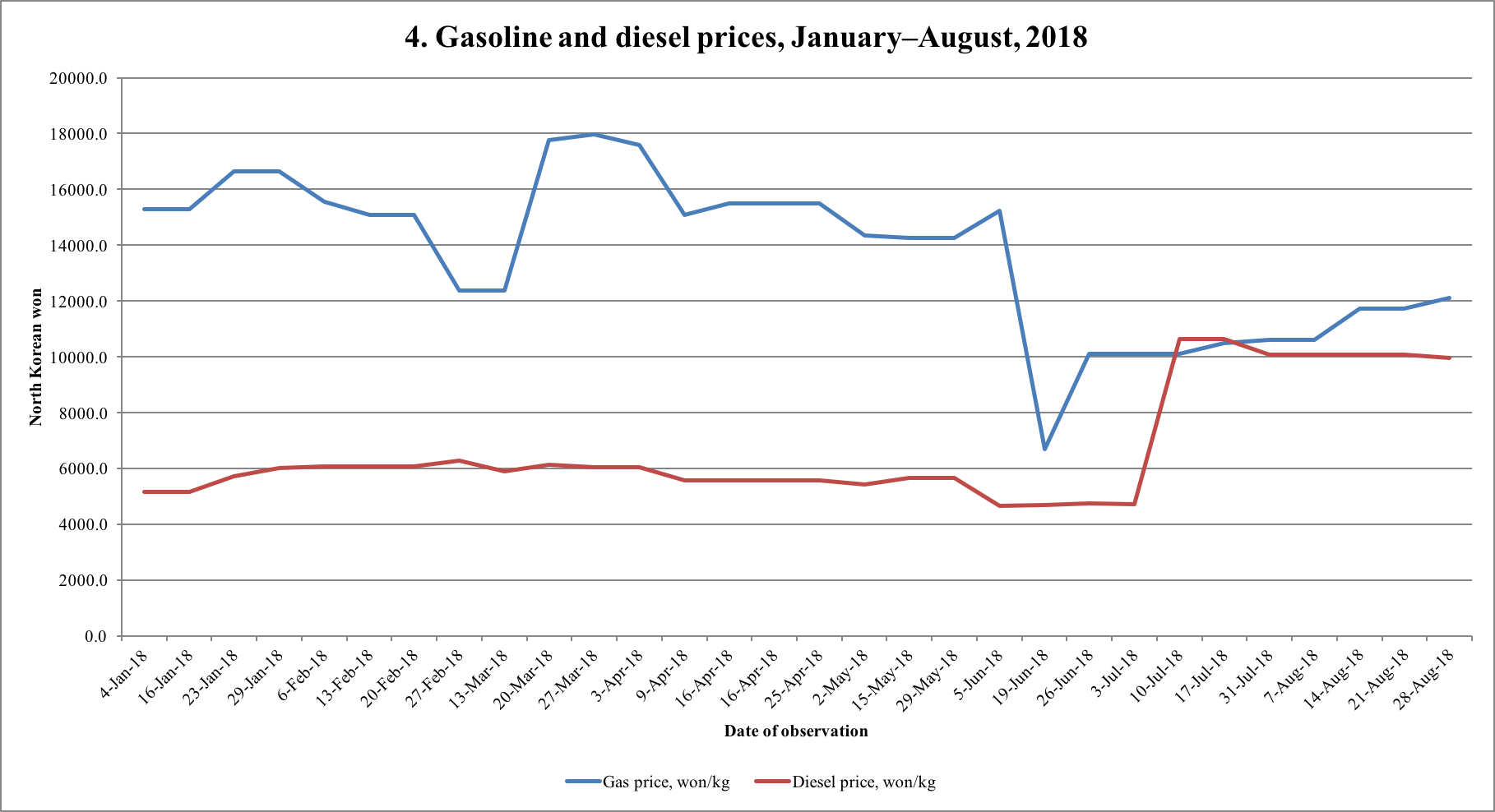
According to recent reports, gas and diesel prices climbed somewhat in the fall, first likely due to increased demand during North Korea’s harvest season and the winter season’s lower temperatures. On December 26, 2018, the price of gasoline stood at 15,200 won per kg—close to the average gasoline price of 14,107 won per kg for the “maximum pressure” period studied in this paper. Graph 5 below shows price developments during the period in question.
After the data below was published, additional reports said that gasoline prices had dropped by 2,500 North Korean won (KPW) in the North Hamgyong province, on the border with China. This would put the price around 13,000 KPW, still higher than average, but much closer to pre-maximum pressure levels. This price drop was reported on January 19, 2019.[13] Kim Jong Un visited China and met with Xi Jinping only ten days earlier. As with other price level changes, it would be impossible to establish a full causal relationship between these two events. It is reasonable to assume, however, that prices went down at least in large part because of increased Chinese supply following Kim’s visit.
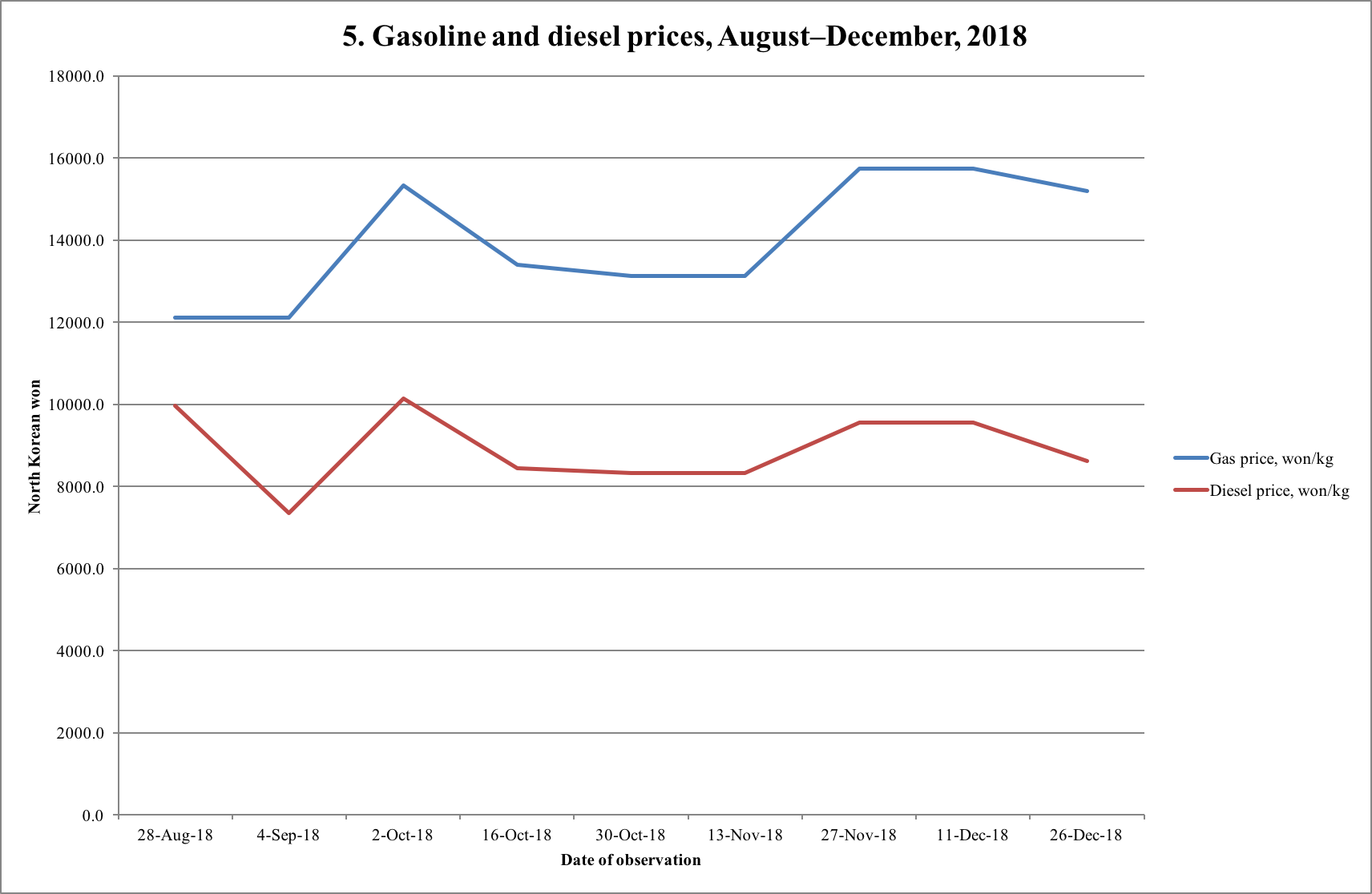
Conclusion
Overall, it seems that fuel prices have reached a general equilibrium. The country remains under heavy international sanctions, but is still able to procure enough fuel to keep most sectors of the economy afloat through a combination smuggling, production of synthetic fuels, gasification of coal and other methods, and Chinese imports and other deliveries. Prices are higher than seasonally normal prior to the latest rounds of particularly harsh sanctions, but have dropped substantially from the high-points of geopolitical tensions in the fall of 2017.
All the data on fuel prices strongly suggest that the pattern of Chinese pressure on North Korea waxes and wanes with geopolitical tensions and Chinese perceptions of whether its national security interests require stringent enforcement of sanctions on North Korea, rather than an abiding commitment to sanctions enforcement regardless of the circumstances. This pattern has held true for much of the history of sanctions on North Korea, and there is little reason to believe that it will change in response to efforts by the Trump administration to turn up the heat on sanctions to coerce Kim Jong Un into meeting US demands on denuclearization.
Download the full report in PDF | China’s Sanctions Enforcement and Fuel Prices in North Korea: What the Data Tells Us
Annex | Case Study: Drastic Price Shifts for Gasoline and Diesel
- [1]
This question is both broad and difficult to answer with certainty, since data from North Korea is both difficult to verify and interpret.
- [2]
Benjamin Katzeff Silberstein, “Peninsula Pressure: China maintains contingencies for North Korean instability,” IHS Jane’s Intelligence Review, September 2017.
- [3]
United Nations Security Council, “Resolution 2397,” adopted on December 22, 2017, accessed at https://www.un.org/ga/search/view_doc.asp?symbol=S/RES/2397%282017%29 on October 18, 2018.
- [4]
See, for a few examples, Ministry of Foreign Affairs of Japan, “Suspicion of illegal ship-to-ship transfers of goods by North Korea-related vessels,” Ministry of Foreign Affairs of Japan, accessed on October 18, 2018, https://www.mofa.go.jp/fp/nsp/page4e_000757.html; Ministry of Foreign Affairs of Japan, “Suspicion of illegal ship-to-ship transfers of goods by JI SONG 6, North Korean-flagged tanker, and small vessel of unknown nationality,” Ministry of Foreign Affairs of Japan, accessed on October 18, 2018, https://www.mofa.go.jp/fp/nsp/page4e_000839.html; Benjamin Katzeff Silberstein, “The North Korean economy in September 2018: an overview,” NK PRO, October 11, 2018, https://t.co/RpCikOdegf.
- [5]
Chinese sanctions enforcement is not the only variable that determines fuel prices inside North Korea. Domestic conditions, though often ignored, play an obvious and crucial role. When, for example, the Korean People’s Army (KPA), needs more fuel for military exercises, parades, contingency stockpiling or the like, market prices rise because the supply available on the open market decreases. The needs of the state take precedence over the needs of the market. Not much is publicly known about the precise moments and reasons for the government soaking up significant amounts of fuel, and such measures by the government will likely only lead to temporary price fluctuations. Patterns in Chinese fuel provisions, on the other hand, should logically cause more long-running price effects, since prices would not shift significantly from single, specific shipments alone.
- [6]
United Nations Security Council, “Resolution 2270,” adopted on March 2, 2016, accessed on October 16, 2018, https://undocs.org/S/RES/2270(2016).
- [7]
Benjamin Katzeff Silberstein, ”CNPC suspends fuel exports to North Korea,” North Korean Economy Watch, June 28, 2017, accessed on October 16, 2018, http://www.nkeconwatch.com/2017/06/28/cnpc-suspends-fuel-exports-to-north-korea/.
- [8]
Patrick D. Cronin and Benjamin Katzeff Silberstein, A Precarious Accord: Navigating the Post-Summit Landscape, Report published by the Asia-Pacific Security Program of the Center for a New American Security (CNAS), Washington, DC, June 2018.
- [9]
“China-North Korea trade drops 59.2% in January-September period: customs,” Global Times, October 13, 2018, http://www.globaltimes.cn/content/1122772.shtml.
- [10]
Lee Kil-seong and Kim Myong-song, “China Doubles Oil Shipments to N.Korea After Kim’s Visit,” Chosun Ilbo, July 19, 2018, accessed at http://english.chosun.com/site/data/html_dir/2018/07/19/2018071901286.html.
- [11]
Ibid.
- [12]
Their data sources three different cities—Pyongyang, Hyesan and Sinuiju—usually on a bi-weekly basis. For simplicity’s sake, the graph shows the average price of these three cities. The dates indicate when the observations were published, which may differ from the precise dates when these prices were in force.
- [13]
Kang Mi-jin, “Pukhan Hwibaryu kyŏngyu kagyŏk harak, sijang hwallyŏksoro chagyonghal tŭt,” Daily NK, January 23, 2019.
